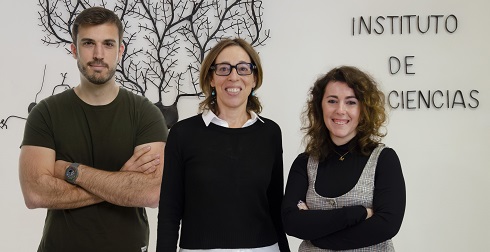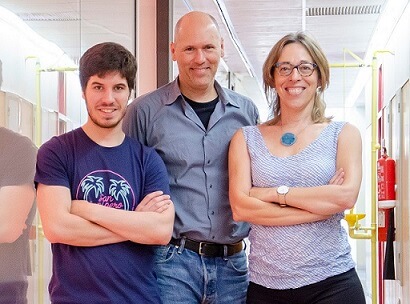Líneas de investigación
Our research is focused on understanding the physiology of presynaptic terminals. We believe that this is important for identifying the first principles underlying biological computation.
Specifically: We are developing a new conceptual framework for the dynamic changes in connection strength that occur at essentially every type of chemical synapse during normal use. The dynamic changes are also known as short-term plasticity. They are cell autonomous, have a presynaptic origin, and occur with timing of milliseconds to tens of minutes, depending on the recent history of use. The directionality, timing, and amplitude of the dynamic changes all vary greatly between individual synapses, suggesting that the mechanisms can be modulated during development, and/or as a result of learning, on a synapse-by-synapse basis. The idea is that the new framework will provide a comprehensive method for categorizing the variation, and that this is needed for understanding how information is encoded, processed, stored, and decoded in neural circuits, and may also help elucidate what goes wrong in some diseases.
We began by developing assays for each of the rate-limiting steps in vesicle cycling at a variety of central synapses using electrophysiological and optical imaging techniques. The assays allowed us to study each step in isolation and to ask how the mechanisms interact with each other. Key results were mathematically simpler than anticipated, but in a way that requires re-thinking conventional views about how vesicle cycling works at the level of cell biology.
For example, the conventional view has been that recycling vesicles accumulate in so called pools that can be recruited for release sequentially during heavy use. However, the nature of the pools has never been well defined, and our studies of rate limiting mechanisms indicated that they must be arranged in parallel and that each serves as an autonomous supply that feeds a single site in the plasma membrane where transmitter release occurs via exocytosis; individual presynaptic terminals typically have around 10 release sites. Follow-up cell biology experiments have now confirmed that individual synaptic terminals do indeed contain multiple reserve pools that are processed in parallel. Intriguingly, it seems that the efficiency of the release machinery can be tuned separately for each release site, endowing each with the capacity to function as a computationally simple frequency filter tuned to transmit the information encoded within a preferred band of spike frequencies.
Currently we are seeking to:
1) Re-evaluate evidence for alternative/competing ideas in the context of the new model.
2) Determine if the composition of the various types of frequency filtering modules within individual synapses can be regulated over the long-term by the activity-dependent stimulation
protocols that control synaptic strength in the contexts of learning and memory and development.
3) Apply the assays developed to isolate rate-limiting steps in vesicle cycling to identify the function of a variety of presynaptic proteins. Current work is focused on the four members of the synaptophysin family.
4) Test morphological predictions of the spatial arrangement of vesicles within presynaptic terminals using electron microscopy tomography.
Publicaciones relevantes
- Parallel processing of quickly and slowly mobilized reserve vesicles in hippocampal synapses. Rodriguez Gotor J J, Mahfooz K, Perez-Otano I & Wesseling J F. eLife 2024 12: RP88212 https://doi.org/10.7554/eLife.88212
- Overlapping role of synaptophysin and synaptogyrin family proteins in determining the small size of synaptic vesicles. Daehun Park, Kenshiro Fujise, Yumei Wu, Rafael Luján, Sergio Del Olmo-Cabrera, John F. Wesseling, and Pietro De Camilli. PNAS. 2024 121 (29) e2409605121 https://doi.org/10.1073/pnas.2409605121
- Considerations for Measuring Activity-Dependence of Recruitment of Synaptic Vesicles to the Readily Releasable Pool Wesseling JF Frontiers Synaptic Neurosc 2019 11:UNSP 32 https://doi.org/10.3389/fnsyn.2019.00032
- Elevated synaptic vesicle release probability in synaptophysin/gyrin family quadruple knockouts Raja MK, Preobraschenski J, Del Olmo-Cabrera S, Martinez-Turrillas R, Jahn R, Perez-Otano I, Wesseling JF eLife 2019 8:e40744 https://doi.org/10.7554/eLife.40744
- Sparse force-bearing bridges between neighboring synaptic vesicles Wesseling JF, Phan S, Bushong EA, Siksou L, Marty S, Pérez-Otaño I, Ellisman M Brain Struct Funct 2019 224(9):3263 https://doi.org/10.1007/s00429-019-01966-x
- Emerging roles of GluN3-containing NMDA receptors in the CNS Perez-Otaño I, Larsen RS, Wesseling JF Nat Rev Neurosci 2016 17(10):623 https://doi.org/10.1038/nrn.2016.92
- GluN3A promotes NMDA spiking by enhancing synaptic transmission in Huntington’s disease models Mahfooz K , Marco S, Martínez-Turrillas R, Raja MK, Pérez-Otaño I, Wesseling JF Neurobiol Dis 2016 93:47:00 https://doi.org/10.1016/j.nbd.2016.04.001
- Parallel processing of quickly and slowly mobilized reserve vesicles in hippocampal synapses. Rodriguez Gotor J J, Mahfooz K, Perez-Otano I & Wesseling J F. eLife 2024 12: RP88212 https://doi.org/10.7554/eLife.88212
- Overlapping role of synaptophysin and synaptogyrin family proteins in determining the small size of synaptic vesicles. Daehun Park, Kenshiro Fujise, Yumei Wu, Rafael Luján, Sergio Del Olmo-Cabrera, John F. Wesseling, and Pietro De Camilli. PNAS. 2024 121 (29) e2409605121 https://doi.org/10.1073/pnas.2409605121
- Altered Cortical Palmitoylation Induces Widespread Molecular Disturbances in Parkinson’s Disease. Cervilla-Martínez, J.F., Rodríguez-Gotor, J.J., Wypijewski, K.J., Fontán-Lozano, Á., Wang, T., Santamaría, E., Fuller, W., Mejías, R. Int J Mol Sci. 2022 23(22): art 14018 https://doi.org/10.3390/ijms232214018
- Control of protein synthesis and memory by GluN3A-NMDA receptors through inhibition of GIT1/mTORC1 assembly. Conde-Dusman MJ, Dey PN, Elía-Zudaire Ó, Rabaneda LG, García-Lira C, Grand T, Briz V, Velasco ER, Andero R, Niñerola S, Barco A, Paoletti P, Wesseling JF, Gardoni F, Tavalin SJ, Perez-Otaño I eLife 2021 10:e71575 https://doi.org/10.7554/eLife.71575
- Editorial: Methods for Synaptic Interrogation Feldmeyer D, Wesseling JF, Sjöström PJ Front Synaptic Neurosci 2020 12:23 https://doi.org/10.3389/fnsyn.2020.00023
- Considerations for Measuring Activity-Dependence of Recruitment of Synaptic Vesicles to the Readily Releasable Pool Wesseling JF Frontiers Synaptic Neurosc 2019 11:UNSP 32 https://doi.org/10.3389/fnsyn.2019.00032
- Elevated synaptic vesicle release probability in synaptophysin/gyrin family quadruple knockouts Raja MK, Preobraschenski J, Del Olmo-Cabrera S, Martinez-Turrillas R, Jahn R, Perez-Otano I, Wesseling JF eLife 2019 8:e40744 https://doi.org/10.7554/eLife.40744
- Sparse force-bearing bridges between neighboring synaptic vesicles Wesseling JF, Phan S, Bushong EA, Siksou L, Marty S, Pérez-Otaño I, Ellisman M Brain Struct Funct 2019 224(9):3263 https://doi.org/10.1007/s00429-019-01966-x
- Emerging roles of GluN3-containing NMDA receptors in the CNS Perez-Otaño I, Larsen RS, Wesseling JF Nat Rev Neurosci 2016 17(10):623 https://doi.org/10.1038/nrn.2016.92
- GluN3A promotes NMDA spiking by enhancing synaptic transmission in Huntington’s disease models Mahfooz K , Marco S, Martínez-Turrillas R, Raja MK, Pérez-Otaño I, Wesseling JF Neurobiol Dis 2016 93:47:00 https://doi.org/10.1016/j.nbd.2016.04.001

 English
English

